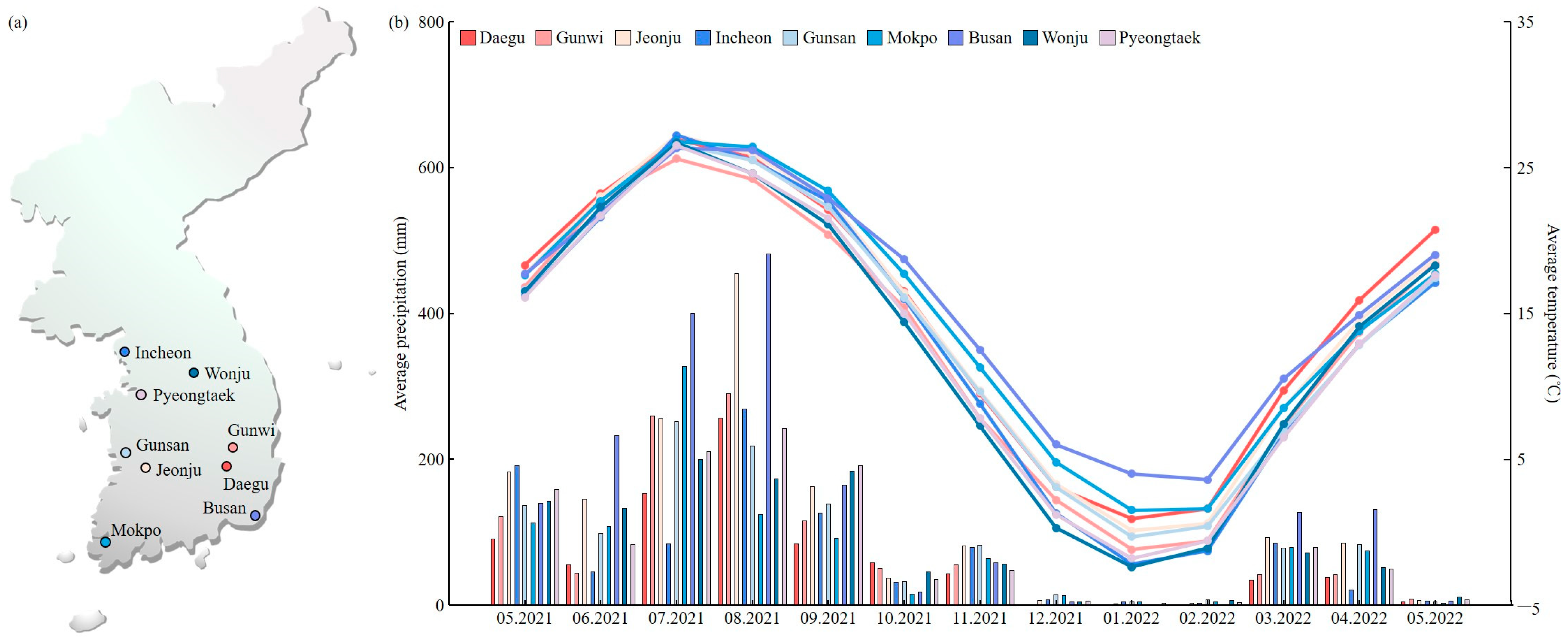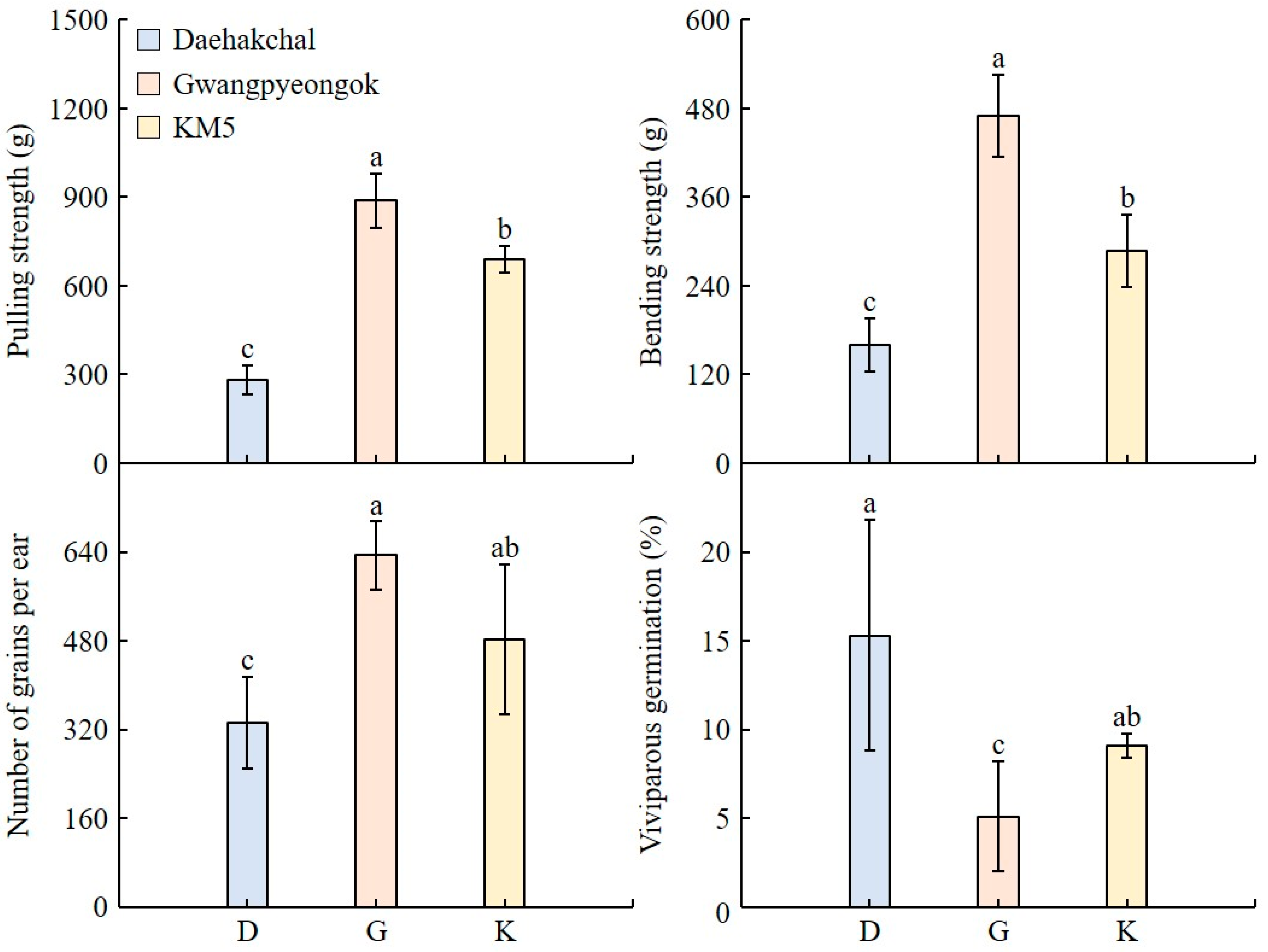Volunteer Plants’ Occurrence and the Environmental Adaptability of Genetically Modified Fodder Corn upon Unintentional Release into the Environment
Abstract
1. Introduction
2. Results
2.1. Analysis of the Germination Rate of Edible and Fodder Corn Grains Based on Temperature
2.2. Comparison of Agricultural Traits between Edible and Fodder Corn
2.3. Viability Analysis of Volunteer Plants Derived from the GM Fodder Corn
2.4. Analysis of the Corn Grain Dormancy Rate and Environmental Conditions at the Loading Ports
2.5. Comparison of Weediness in the Edible and Fodder Corn
3. Discussion
4. Materials and Methods
4.1. Corn Cultivation and Analysis of Agricultural Traits
4.2. Germination Rate Analysis of Seeds for Fodder and Consumption by Temperature
4.3. Analysis of the Occurrence of Volunteer Plants Resulting from the Unintentional Release of GM Corn Feed
4.4. Analysis of Weediness Potential in the Edible and Fodder GM Corn Grain
4.5. Investigation of the Dormancy Rate of Corn Grains by Region
4.6. Investigation of Average Temperature and Precipitation in Areas located near the GM Seed Distribution Pathways
4.7. Statistical Analysis
5. Conclusions
Author Contributions
Funding
Data Availability Statement
Acknowledgments
Conflicts of Interest
References
- Khoury, C.K.; Achicanoy, H.A.; Bjorkman, A.D.; Navarro-Racines, C.; Guarino, L.; Flores-Palacios, X.; Engels, J.M.M.; Wiersema, J.H.; Dempewolf, H.; Sotelo, S.; et al. Origins of Food Crops Connect Countries Worldwide. Proc. R. Soc. B Biol. Sci. 2016, 283, 792–800. [Google Scholar] [CrossRef]
- Thierfelder, C.; Matemba-Mutasa, R.; Rusinamhodzi, L. Yield Response of Maize (Zea mays L.) to Conservation Agriculture Cropping System in Southern Africa. Soil Tillage Res. 2015, 146, 230–242. [Google Scholar] [CrossRef]
- Zhou, M.; Luo, H. MicroRNA-Mediated Gene Regulation: Potential Applications for Plant Genetic Engineering. Plant Mol. Biol. 2013, 83, 59–75. [Google Scholar] [CrossRef]
- Kamthan, A.; Chaudhuri, A.; Kamthan, M.; Datta, A. Genetically Modified (GM) Crops: Milestones and New Advances in Crop Improvement. Theor. Appl. Genet. 2016, 129, 1639–1655. [Google Scholar] [CrossRef] [PubMed]
- Kim, S.H.; Kim, H.; Oh, S.H. Talking about Genetically Modified (GM) Foods in South Korea: The Role of the Internet in the Spiral of Silence Process. Mass Commun. Soc. 2014, 17, 713–732. [Google Scholar] [CrossRef]
- Zetterberg, C.; Edvardsson Björnberg, K. Time for a New EU Regulatory Framework for GM Crops? J. Agric. Environ. Ethics 2017, 30, 325–347. [Google Scholar] [CrossRef]
- Ladics, G.S.; Bartholomaeus, A.; Bregitzer, P.; Doerrer, N.G.; Gray, A.; Holzhauser, T.; Jordan, M.; Keese, P.; Kok, E.; Macdonald, P.; et al. Genetic Basis and Detection of Unintended Effects in Genetically Modified Crop Plants. Transgenic Res. 2015, 24, 587–603. [Google Scholar] [CrossRef] [PubMed]
- Kumlehn, J.; Pietralla, J.; Hensel, G.; Pacher, M.; Puchta, H. The CRISPR/Cas Revolution Continues: From Efficient Gene Editing for Crop Breeding to Plant Synthetic Biology. J. Integr. Plant Biol. 2018, 60, 1127–1153. [Google Scholar] [CrossRef]
- Smyth, S.J.; Phillips, P.W.B.; Kerr, W.A. Food Security and the Evaluation of Risk. Glob. Food Secur. 2015, 4, 16–23. [Google Scholar] [CrossRef]
- Zhang, X.; Liu, Y.; Liu, Y.; Cui, Q.; Yang, L.; Hu, X.; Guo, J.; Zhang, J.; Yang, S. Impacts of Climate Change on Self-Sufficiency of Rice in China: A CGE-Model-Based Evidence with Alternative Regional Feedback Mechanisms. J. Clean. Prod. 2019, 230, 150–161. [Google Scholar] [CrossRef]
- Fukase, E.; Martin, W. Who Will Feed China in the 21st Century? Income Growth and Food Demand and Supply in China. J. Agric. Econ. 2016, 67, 3–23. [Google Scholar] [CrossRef]
- Wang, J.; Liu, Q.; Hou, Y.; Qin, W.; Lesschen, J.P.; Zhang, F.; Oenema, O. International Trade of Animal Feed: Its Relationships with Livestock Density and N and P Balances at Country Level. Nutr. Cycl. Agroecosyst. 2018, 110, 197–211. [Google Scholar] [CrossRef]
- Erenstein, O.; Jaleta, M.; Sonder, K.; Mottaleb, K.; Prasanna, B.M. Global Maize Production, Consumption and Trade: Trends and R&D Implications. Food Secur. 2022, 14, 1295–1319. [Google Scholar]
- Shen, C.; Yin, X.-C.; Jiao, B.-Y.; Li, J.; Jia, P.; Zhang, X.-W.; Cheng, X.-H.; Ren, J.-X.; Lan, H.-D.; Hou, W.-B.; et al. Evaluation of Adverse Effects/Events of Genetically Modified Food Consumption: A Systematic Review of Animal and Human Studies. Environ. Sci. Eur. 2022, 34, 1–33. [Google Scholar] [CrossRef]
- Séralini, G.E.; Mesnage, R.; Defarge, N.; Gress, S.; Hennequin, D.; Clair, E.; Malatesta, M.; de Vendômois, J.S. Answers to Critics: Why There Is a Long Term Toxicity Due to a Roundup-Tolerant Genetically Modified Maize and to a Roundup Herbicide. Food Chem. Toxicol. 2013, 53, 476–483. [Google Scholar] [CrossRef]
- Séralini, G.E.; Clair, E.; Mesnage, R.; Gress, S.; Defarge, N.; Malatesta, M.; Hennequin, D.; de Vendômois, J.S. Republished Study: Long-Term Toxicity of a Roundup Herbicide and a Roundup-Tolerant Genetically Modified Maize. Environ. Sci. Eur. 2014, 26, 1–17. [Google Scholar] [CrossRef]
- Kim, N.H.; Hwang, J.Y.; Lee, H.G.; Song, M.K.; Kang, Y.S.; Rhee, M.S. Strategic Approaches to Communicating with Food Consumers about Genetically Modified Food. Food Control 2018, 92, 523–531. [Google Scholar] [CrossRef]
- Oliveira, L.; Messagie, M.; Rangaraju, S.; Sanfelix, J.; Hernandez Rivas, M.; Van Mierlo, J. Key Issues of Lithium-Ion Batteries—From Resource Depletion to Environmental Performance Indicators. J. Clean. Prod. 2015, 108, 354–362. [Google Scholar] [CrossRef]
- Yoon, A.M.; Kim, I.R.; Lim, H.S.; Lee, J.R.; Choi, W. Development of a Loop-Mediated Isothermal Amplification Assay for Living Modified Canola GT73. Plant Biotechnol. Rep. 2022, 16, 479–486. [Google Scholar] [CrossRef]
- Beacham, T.A.; Sweet, J.B.; Allen, M.J. Large Scale Cultivation of Genetically Modified Microalgae: A New Era for Environmental Risk Assessment. Algal Res. 2017, 25, 90–100. [Google Scholar] [CrossRef]
- Zhang, C.; Wohlhueter, R.; Zhang, H. Genetically Modified Foods: A Critical Review of Their Promise and Problems. Food Sci. Hum. Wellness 2016, 5, 116–123. [Google Scholar] [CrossRef]
- Wunderlich, S.; Gatto, K.A. Consumer Perception of Genetically Modified Organisms and Sources of Information. Adv. Nutr. 2015, 6, 842–851. [Google Scholar] [CrossRef]
- Nijar, G.S. The Nagoya-Kuala Lumpur Supplementary Protocol on Liability and Redress to the Cartagena Protocol on Biosafety: An Analysis and Implementation Challenges. Int. Environ. Agreem. 2013, 13, 271–290. [Google Scholar] [CrossRef]
- Gosal, S.S.; Wani, S.H. Biotechnologies of Crop Improvement, Volume 2: Transgenic Approaches; Springer International Publishing: Berlin/Heidelberg, Germany, 2018; ISBN 9783319906508. [Google Scholar]
- Afzal, M.; Hindawi, S.E.S.; Alghamdi, S.S.; Migdadi, H.H.; Khan, M.A.; Hasnain, M.U.; Arslan, M.; Habib ur Rahman, M.; Sohaib, M. Potential Breeding Strategies for Improving Salt Tolerance in Crop Plants. J. Plant Growth Regul. 2022, 42, 3365–3387. [Google Scholar] [CrossRef]
- Yang, N.; Liu, J.; Gao, Q.; Gui, S.; Chen, L.; Yang, L.; Huang, J.; Deng, T.; Luo, J.; He, L.; et al. Genome Assembly of a Tropical Maize Inbred Line Provides Insights into Structural Variation and Crop Improvement. Nat. Genet. 2019, 51, 1052–1059. [Google Scholar] [CrossRef] [PubMed]
- Coupe, R.H.; Capel, P.D. Trends in Pesticide Use on Soybean, Corn and Cotton since the Introduction of Major Genetically Modified Crops in the United States. Pest Manag. Sci. 2016, 72, 1013–1022. [Google Scholar] [CrossRef]
- Yadava, P.; Abhishek, A.; Singh, R.; Singh, I.; Kaul, T.; Pattanayak, A.; Agrawal, P.K. Advances in Maize Transformation Technologies and Development of Transgenic Maize. Front. Plant Sci. 2017, 7, 1949–1960. [Google Scholar] [CrossRef]
- Ververis, E.; Ackerl, R.; Azzollini, D.; Colombo, P.A.; de Sesmaisons, A.; Dumas, C.; Fernandez-Dumont, A.; Ferreira da Costa, L.; Germini, A.; Goumperis, T.; et al. Novel Foods in the European Union: Scientific Requirements and Challenges of the Risk Assessment Process by the European Food Safety Authority. Food Res. Int. 2020, 137, 109515–109525. [Google Scholar] [CrossRef]
- Nicolia, A.; Manzo, A.; Veronesi, F.; Rosellini, D. An Overview of the Last 10 Years of Genetically Engineered Crop Safety Research. Crit. Rev. Biotechnol. 2014, 34, 77–88. [Google Scholar] [CrossRef]
- Tsatsakis, A.M.; Nawaz, M.A.; Kouretas, D.; Balias, G.; Savolainen, K.; Tutelyan, V.A.; Golokhvast, K.S.; Lee, J.D.; Yang, S.H.; Chung, G. Environmental Impacts of Genetically Modified Plants: A Review. Environ. Res. 2017, 156, 818–833. [Google Scholar] [CrossRef]
- Strauss, S.H.; Sax, J.K. Ending Event-Based Regulation of GMO Crops. Nat. Biotechnol. 2016, 34, 474–477. [Google Scholar] [CrossRef] [PubMed]
- Flipse, S.M.; Osseweijer, P. Media Attention to GM Food Cases: An Innovation Perspective. Public Underst. Sci. 2013, 22, 185–202. [Google Scholar] [CrossRef]
- Singh, R.P.; Prasad, P.V.V.; Reddy, K.R. Impacts of Changing Climate and Climate Variability on Seed Production and Seed Industry. In Advances in Agronomy; Academic Press Inc.: Cambridge, MA, USA, 2013; Volume 118, pp. 49–110. [Google Scholar]
- Maity, A.; Lamichaney, A.; Joshi, D.C.; Bajwa, A.; Subramanian, N.; Walsh, M.; Bagavathiannan, M. Seed Shattering: A Trait of Evolutionary Importance in Plants. Front. Plant Sci. 2021, 12, 657773–657789. [Google Scholar] [CrossRef] [PubMed]
- Jeon, D.W.; Park, J.R.; Jang, Y.H.; Kim, E.G.; Ryu, T.; Kim, K.M. Safety Verification of Genetically Modified Rice Morphology, Hereditary Nature, and Quality. Environ. Sci. Eur. 2021, 33, 73–84. [Google Scholar] [CrossRef]




| Year | Amount of Sowing (kg) | 100-Grain Weight Conversion Quantity | Number of Plants | Rate of Germination (%) |
|---|---|---|---|---|
| 2021 | 75 | 214,300 | 28 | 0.01 |
| 2022 | 20 | 57,100 | 39 | 0.07 |
Disclaimer/Publisher’s Note: The statements, opinions and data contained in all publications are solely those of the individual author(s) and contributor(s) and not of MDPI and/or the editor(s). MDPI and/or the editor(s) disclaim responsibility for any injury to people or property resulting from any ideas, methods, instructions or products referred to in the content. |
© 2023 by the authors. Licensee MDPI, Basel, Switzerland. This article is an open access article distributed under the terms and conditions of the Creative Commons Attribution (CC BY) license (https://creativecommons.org/licenses/by/4.0/).
Share and Cite
Choi, H.-Y.; Kim, E.-G.; Park, J.-R.; Jang, Y.-H.; Jan, R.; Farooq, M.; Asif, S.; Kim, N.; Kim, J.-H.; Gwon, D.; et al. Volunteer Plants’ Occurrence and the Environmental Adaptability of Genetically Modified Fodder Corn upon Unintentional Release into the Environment. Plants 2023, 12, 2653. https://doi.org/10.3390/plants12142653
Choi H-Y, Kim E-G, Park J-R, Jang Y-H, Jan R, Farooq M, Asif S, Kim N, Kim J-H, Gwon D, et al. Volunteer Plants’ Occurrence and the Environmental Adaptability of Genetically Modified Fodder Corn upon Unintentional Release into the Environment. Plants. 2023; 12(14):2653. https://doi.org/10.3390/plants12142653
Chicago/Turabian StyleChoi, Han-Yong, Eun-Gyeong Kim, Jae-Ryoung Park, Yoon-Hee Jang, Rahmatullah Jan, Muhammad Farooq, Saleem Asif, Nari Kim, Ji-Hun Kim, Dohyeong Gwon, and et al. 2023. "Volunteer Plants’ Occurrence and the Environmental Adaptability of Genetically Modified Fodder Corn upon Unintentional Release into the Environment" Plants 12, no. 14: 2653. https://doi.org/10.3390/plants12142653
APA StyleChoi, H.-Y., Kim, E.-G., Park, J.-R., Jang, Y.-H., Jan, R., Farooq, M., Asif, S., Kim, N., Kim, J.-H., Gwon, D., Lee, S.-B., Jeong, S.-K., & Kim, K.-M. (2023). Volunteer Plants’ Occurrence and the Environmental Adaptability of Genetically Modified Fodder Corn upon Unintentional Release into the Environment. Plants, 12(14), 2653. https://doi.org/10.3390/plants12142653








